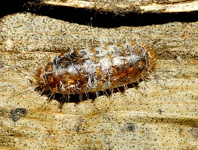Abstract
This short communication addresses the problem associated with the current taxonomic status of the prehistoric edentate genus Neocnus Arredondo, 1961 (with type species Micronocnus gliriformis Matthew, 1931) which has long been considered a senior homonym of the dendrochirotid sea cucumber genus Neocnus Cherbonnier, 1972 (type species Neocnus incubans Cherbonnier, 1972) and replaces the latter (junior homonym) with Incubocnus n.g. The diagnosis of the new genus is the same as the cucumariid Neocnus as amended by O’Loughlin & O’Hara (1992). A brief history of the senior homonym Neocnus (Edentata) is given followed by a short literature survey dealing with its junior homonym.
References
Alvà, V. & Jangoux, M. (1992) Brooding and marsupium structure in the cucumariid holothuroid Neocnus incubans (Echinodermata). Echinoderm Research, 1991, 121–123.
Alvá, V. (1991) On three species of Mediterranean echinoderms. Scientia marina, 55 (2), 211–219.
Arredondo, O. (1961) Descripciones preliminares de dos nuevos géneros y especies de edentados del Pleistoceno cubano. Boletin del Grupo de Exploraciones Cientificas, 1, 9–40.
Cherbonnier, G. (1972) Neocnus incubans, nouveau genre et nouvelle espèce d'holothurie dendrochirote incubatrice de Méditerranée. Comptes Rendus Academie Sciences, Paris, Série D, 275, 225–227.
Hansson, H.G. (2001) Echinodermata. In: Costello, M.J. (Ed.) European register of marine species: a check-list of the marine species in Europe and a bibliography of guides to their identification. Collection Patrimoines Naturels, 50, pp. 336–351.
Hernández, J.C., Clemente, S., Tuya, F., Pérez-Ruzafa, A., Sangil, C., Moro-Abad, L. & Bacallado-Aránega, J.J. (2013) Echinoderms of the Canary Islands, Spain. In: Echinoderm Research and Diversity in Latin America. Springer, Berlin Heidelberg, pp. 471–510.
https://doi.org/10.1007/978-3-642-20051-9_15Kretzoi, M. (1968) New generic names for homonyms (Cubanocnus for Microcnus ...). Vertebrata Hungaricae, 10 (112), 163–165.
MacPhee, R.D.E., White, J.L. & Woods, C.A. (2000) New megalonychid sloths (Phyllophaga, Xenarthra) from the Quaternary of Hispanlola. American Museum Novitates, 3303, 1–32.
https://doi.org/10.1206/0003-0082(2000)3303%3C0001:NMSPXF%3E2.0.CO;2Matthew, W.D. (1931) Genera and new species of ground sloths from the Pleistocene of Cuba. American Museum Novitates, 511, 1–5.
Mayo, N. (1980) Revision de Neocnus major Arredondo, 1961 (Mammalia: Edentata del Pleistoceno de Cuba) con descripción de un cráneo y algunos huesos postcraneales. Estudios Geológicos, 36, 427–440.
Miller, G.S. Jr. (1929) A second collection of mammals from caves near St. Michel, Haiti. Smithsonian Miscellaneous Collections, 81 (9), 1–30.
O’Loughlin, P.M. (1991) Brooding and fission in shallow water echinoderms of southern Australia. In: Yanagisawa, T., Yasumasu, I., Oguro, C., Suzuki, N. & Motoawa, T. (Eds.), Biology of Echinodermata. Balkema, Rotterdam, 223-228.
O’Loughlin, P.M. & O’Hara, T.D. (1992) New cucumariid holothurians (Echinodermata) from southern Australia, including two brooding and one fissiparous species. Memoirs of the Museum of Victoria, 53 (2), 227–266.
Paula Couto, Cde. (1967) Pleistocene edentates of the West Indies. American Museum Novitates, 2304, 1–55.
Pérez-Ruzafa, A. (1984) Estudio sistemático, ecológico y biogeográfico de la clase Holothurioidea (Echinodermata) en las Islas Canarias. Licenciatura Thesis, Universiteit de La Laguna, Tenerife, 419 pp.
Silva Taboada, G., Suarez Duque, W. & Diaz Franco, S. (2007) Compendio de los mamiferos terrestres autoctonos de Cuba vivientes y extinguidos. Museo Nacional de Historia Natural, Habana, 465 pp.
Vail, F.W.E. & Rowe, L.L. (1982) The distributions of Tasmanian echinoderms in relation to southern Australian biogeographic provinces. Echinoderms, 219–225.
Varona, L.S. (1976) Reemplazo de Cubanocnus por Neocnus (Mammalia: Edentata). Misc. Zool, 2, 1–4.

